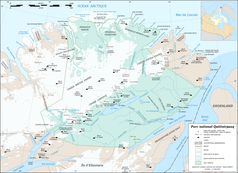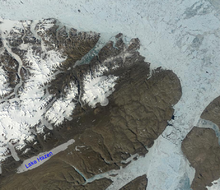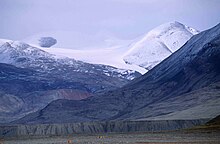Quttinirpaaq National Park
| Quttinirpaaq National Park | ||
|---|---|---|
| Northeast end of Tanquary Fjord with Parks Canada camp and runway; in the background: Delta of Air Force River and Rollrock River; right: mouth of the Macdonald River | ||
|
|
||
| Location: | Nunavut , Canada | |
| Next city: | Grise Fiord | |
| Surface: | 38,000 km² | |
| Founding: | 1988 | |
| Visitors: | 21 (2016/2017) | |
| Address: |
Quttinirpaaq National Park P.O. Box 278 Iqaluit, Nunavut Tel. (867) 975-4673 |
|
| National park map | ||
The Quttinirpaaq National Park (officially English Quttinirpaaq National Park of Canada , French Parc national du Canada Quttinirpaaq / alternatively also Quttinirtaaq National Park ) is with an area of 37,775 square kilometers the largest national park of Nunavut and the second largest of the currently 47 national parks in Canada as well as the furthest north of them. His Inuktitut name means "top of the world". In 1988, significant parts of the north of Ellesmere Island were raised to a protected area under the name "Ellesmere National Park Reserve"; In 1999 the area was given the name "Quttinirpaaq", and the Canadian National Park Ordinance of February 19, 2001 finally made it a national park.
geography
Geographically, the Quttinirpaaq National Park covers the north of Ellesmere Island with the exception of a larger area around the Canadian military station Alert in the extreme northeast of the island. The national park represents a very rugged area, far removed from any civilization, of almost 20 percent of the island, which corresponds to about 10 percent of the area of Germany.
The coasts of the national park are enclosed by the Arctic Ocean and are strongly jagged by glacial valleys , deep land gaps and a total of seven fjords. Where in the far north the mountains of Grant Land, the northern part of the park, slope down to the ocean, unique sea ice sheets up to 80 meters thick have been binding sea and land together for several millennia. One of these ice sheets, the “Ward Hunt Ice Shelf” near the Disraeli Fiord (82 ° 53 ′ n. Br., 73 ° 03 ′ w. L.) broke in the summer of 2002.
Both the by folding in the Paleozoic incurred Innuitians belonging mountain ranges United States Range and British Empire Range of Grant Land (parts of the Arctic Cordillera ) are from one to 1,000 meters high, even from the last ice age coming ice cap (Grantland Ice Cap) and some smaller ice caps. From it rise mountain peaks as nunataks , below
- the Barbeau Peak (81 ° 54 ′ 30 ″ n. Br., 75 ° 01 ′ 30 ″ w. L.), with 2,616 meters highest mountain in Nunavut,
- of Mount Whisler (82 ° 00 '42 "n. Br., 74 ° 32' 18" W. L.), of 2.500 meters, the second highest peak Ellesmere Island, 12 km northeast of the Barbeau peak from Henrietta-Nesmith Glacier all included, and
- of Mount Eugene (82 ° 24 '18 "n. Br., 66 ° 38' 39" W. L.), 63 kilometers west of the military station Alert.
To the south and east of the mountain ranges, the land in the center of the national park drops abruptly. At a height of only 158 meters above sea level. d. Here lies the Hazensee (81 ° 38 'to 81 ° 58' n. Br., 68 ° 55 'to 72 ° 58' w. L.). This lake, protected in the north by the Garfield mountain range and in the south by the Hazen Plateau, represents a thermal "oasis" that remains frost-free for around 70 days in summer with average midday temperatures of up to 20 ° C. The only outflow is the 22 km long Ruggles River , whose exit from the lake does not freeze completely even at −60 ° C; it flows into the Chandler Fjord , the waters of which flow through the Conybeare Fjord and Lady Franklin Bay to the Nares Strait .
The rugged Hazen Plateau ends in the east at the 600-meter-deep cliffs of the Archer Fjord and the Robenson Canal.
Climatic conditions
With annual rainfall of only 60 millimeters, Quttinirpaaq is one of the driest areas in the northern hemisphere, a so-called polar desert.
history
In the area of the Quttinirpaaq National Park there are traces of more than 4,000 years of human settlement. The first humans were Paleo-Eskimos of the pre-Dorset culture ; they were later followed by members of the Dorset culture and finally the Thule culture . The last group of people disappeared from Ellesmere Island during the Little Ice Age (1600-1850).
In 1882 the then lieutenant and later General Adolphus Washington Greely discovered the sea from the American research station Fort Conger , which was operated during the First International Polar Year . He was also the first to report on the surrounding mountains and glaciers.
During the International Geophysical Year (July 1, 1957 to December 31, 1958), the "Hazen Camp" was set up as a research base on the north shore of the lake opposite St. John's Island (81 ° 49 ′ n. Br., 71 ° 25 ′ w . L.). Since the region around the lake was not covered by glaciers during the last ice age, pre-ice age organisms were able to survive here, which is still the basis of great scientific interest after 1958 until today.
Access to Quttinirpaaq National Park
The gateway to the national park is a camp (81 ° 25 ′ n. Br., 76 ° 45 ′ w. L.) built by Jamesway tent huts on the Tanquary Fjord by Parks Canada, which can be reached by a supply ship depending on the ice conditions. Small planes can also land at Tanquary Fiord Airfield . During the summer the camp is manned by park rangers (Parks Canada Rangers) for about two and a half months. One of the most important tasks of these rangers is to record the entire game population every year in a four-day action with the assistance of an airplane or helicopter. The entire plant population is also to be determined and checked for changes at ten-year intervals.
flora
The glacier regions of the national park give only limited space for vegetation. Over time, however, soil crumbs have developed on terminal moraines , lateral moraines , Eskern and other glacier bottoms, so that not only lichens and mosses but also vascular plants could settle in sheltered, ice-free zones facing the sun. Especially in areas where groundwater accumulates, nutrient-rich soils formed as the basis for vegetation, and so a rich flora and fauna has developed in the Hazensee oasis. In late July, early August bloom in the moss - lichen - and grass mats especially different willow species , the yellow Arctic poppies , the White Mountain Avens and the red cushion stems lots Leimkrauts . A total of about 130 plant species were counted.
fauna
Land mammals
Herbivores , primarily musk ox , peary caribou , polar hare and lemmings , serve as food for these plants. In turn, they fall prey to arctic wolves , which have been at home here for over 1,000 years. Also polar foxes live here. There are currently around 20 wolves, 200 peary caribou and 2,000 musk oxen living in the park area.
Birds
Over 30 species of birds, including petrels , arctic terns , skuas and other species of gulls breed in the area of the national park in summer.
Marine mammals and fish
Ringed seals , bearded seals , walruses and occasionally whales and polar bears can be found on the coasts of the sea . The only species of fish in the Hazensee is the arctic char .
Tourist notes
Every year two or three groups of visitors come to the Tanquary Fjord as day trippers and around forty tourers with charter planes. Tourers usually set off from here to hike to Lake Hazen on one of the usual routes in 8 to 12 days . The return is usually made on a pre-booked charter plane. Sometimes the reverse route is also chosen. During their tour, the hikers always stay in radio contact with the base camp.
In the Parks Canada Camp all current information about the park visit is given, e.g. For example, there are also references to restricted areas such as the areas with wolf birth caves, which are no longer allowed to be entered to protect the endangered arctic wolves.
literature
- Nunavut Handbook, Iqaluit 2004, ISBN 0-9736754-0-3











